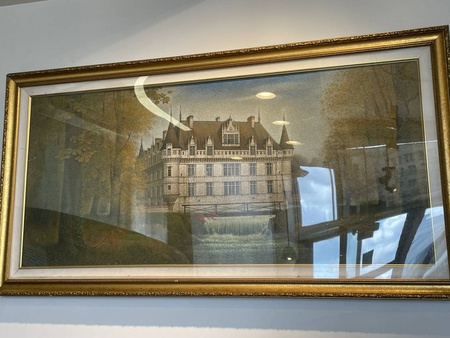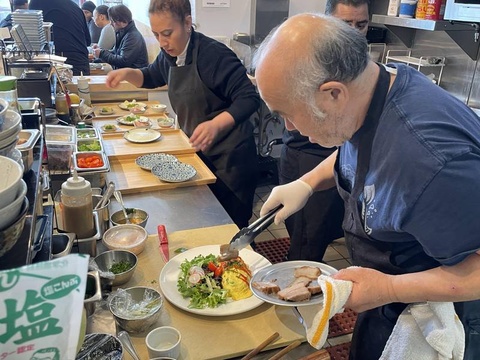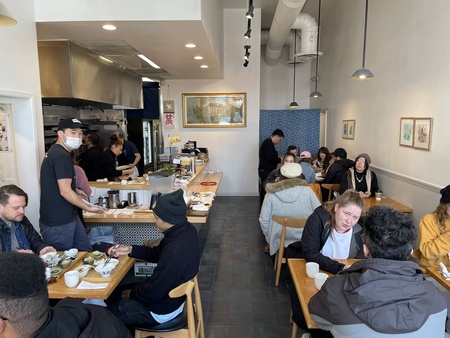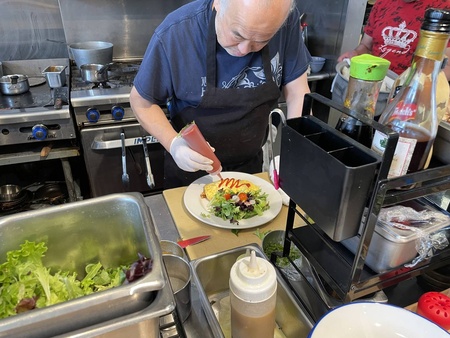At Azay in Little Tokyo, Akira Hirose uses his French and Japanese cuisine to serve the local community.
In 1991, Akira Hirose worked as a chef at the Peninsula Hotel in Beverly Hills. While he was trained in French cooking, his boss asked him, “Chef Akira, can you do something to add in an Asian twist?”
The restaurant had a Hong Kong background, but Akira was not too familiar with Chinese cuisine. Instead, he decided to pick ingredients from his home country: Japan.
“I started using wasabi. I started using miso,” he said. Thus, his signature miso-marinated Chilean sea bass was born, as was his unique duality of Japanese and French cuisine.
Two years later, he joined the Transamerica Building’s Tower Restaurant, where he served an unexpected guest.
“I was very happy to receive the Japanese Emperor and the Empress to the Tower Restaurant,” he said. “I served to them that miso-marinated Chilean sea bass. One time lunch. But if my grandfather was alive, he [would have been] so happy.”
Born in Kyoto, Japan, Hirose’s life and career was a global one, as he bounced between countries to pursue a career he had in mind since he was eight years old.
“You know, sometimes the elementary school teacher asks you, ‘what do you want to be in the future?’ recalls Hirose. “ Some students said, ‘I want to be a nurse,’ ‘I want to be a policeman,’ ‘I want to be a baseball player…’ but I wrote, ‘I want to be a chef.’”

He began by studying in France for eight years before he arrived in Los Angeles for the first time in 1981, taking a job at a restaurant named L’Orangerie, where he met his future wife.
He worked several jobs, opened a restaurant in Kyoto, and eventually settled in Pasadena in 1998, running a fine dining restaurant named Maison Akira that served French and Japanese cuisine.
But after 20 years there, he closed its doors and returned to his roots in L.A.’s Little Tokyo in 2019 with a casual eatery named Azay, after the French commune where he once worked.
“Now I help the Japanese American community most of the time with a small restaurant, three times smaller than before… no white tablecloths… but now it’s an open kitchen,” he said. “I can see people enjoy, laughing, and when I see people having a good time with a good meal, I’m happy.”
On a usual day, the restaurant is buzzing with life, as Hirose and his team work to cook, plate and serve food to customers. People even make reservations just to have lunch at the restaurant.
Beyond cultural influence, each dish on Hirose’s menu has an aspect of his life and family woven into it. “Barbecue eel. It’s called hitsumabushi… you eat it two ways: straight like this with rice and another you put in broth,” he explains. “ So that’s Nagoya style. Why do [I] have it? Because my mom went to high school [there]. Every dish has a connection.”
But creating a unique menu isn’t Hirose’s only responsibility and as a business owner, the post-pandemic world has brought on new challenges. “I think the pandemic changed especially young people’s minds… the government started giving away money to the employees,” he said. “So now, they want to make money without working, so it’s a hard time to find [staff].”
He is not alone, as Azay is a family endeavor with his wife and son helping to run the restaurant beside their usual jobs.
His wife, Jo Ann Hirose, helps manage Azay outside of her career as a dental hygienist and even contributes to finding healthier options for the menu. “This restaurant is truly a family business. Although he, Akira, is the only one fully vested in the business,” she said.
She said that her husband’s gastronomic intrigue continues at home. “Once we get home, he is not cooking but he is watching YouTube videos, studying what’s current in the culinary field… he tries to keep up to date on especially the French and the Japanese culinary scene.”
Still, a family-run restaurant is not without its disagreements according to Akira Hirose. “We fight, of course, families fight… but we fight for a good reason because we care about this business,” he chuckled.
Azay opened just a few months before the pandemic started, but Hirose adapted to their situation. Offering to-go options, he said that during holidays, they received three times the amount of business than he did when running Maison Akira.
Mariko Lochridge, a small business consultant at the Little Tokyo Service Center, worked with Hirose during the pandemic to provide meals to low-income families in Little Tokyo.
Now, the LTSC is one of the organizations that reaches out to Hirose to cater at their local community events.
“He’s always thinking about how the menu can best serve the guests at the event,” she said. “There’s no difference for him if he’s serving an 80-year-old senior who lives in affordable housing or if he’s making a meal for the imperial family of Japan.”
Michael Murata, a local musician and a friend of the Hirose family, echoes these sentiments. He was previously invited to perform at Azay.
“[Hirose] has great presence because he goes so far out of his way to make sure that everyone that he meets is well fed,” Murata said. “He’s making sure that the community events have what they need, and he offers what he can.”
Recently, Hirose catered for a youth leadership event and the LTSC’s New Years Party for local seniors. To him, Azay’s relationship to the community is crucial to his restaurant’s identity.
“Seller happy, buyer happy, and the community happy. If [these] three things should be happy, then I think business can continue for long time,” he said.
This heart for community is also the root of his aspirations after Azay, as he looks to pass on his cooking.
“After I retire, I want to maybe teach, giving the class at a temple or church,” he said. “I think that this is my goal to give my knowledge to the next generation.”
Through it, Hirose hopes to share more than his recipes and his dishes, but inspire people to pursue their ambitions, even those that seem distant.
“Everybody should have a type of dream, big dream,” he said. “Even if we climb up Mount Fuji, even the highest mountain in California. You have to do that one by one, one step by step. If you don’t stop, you can make it.”
*This article was originally published in USC Annenberg Media on March 21, 2023.
© 2023 Ethan Huang






